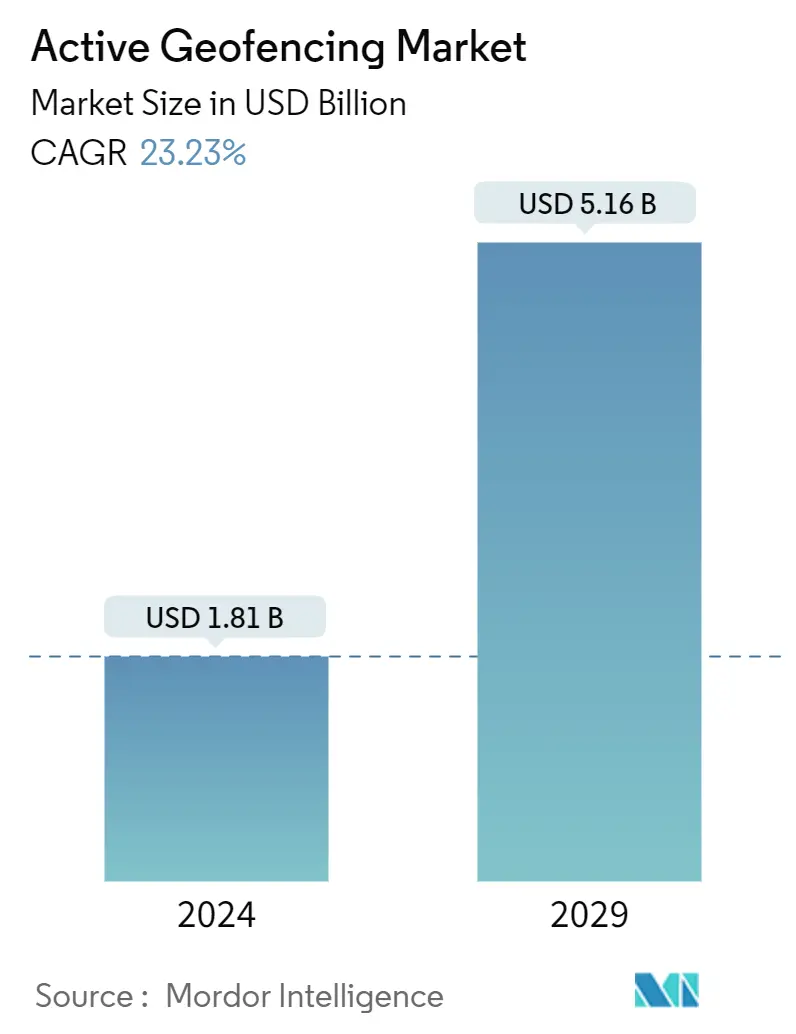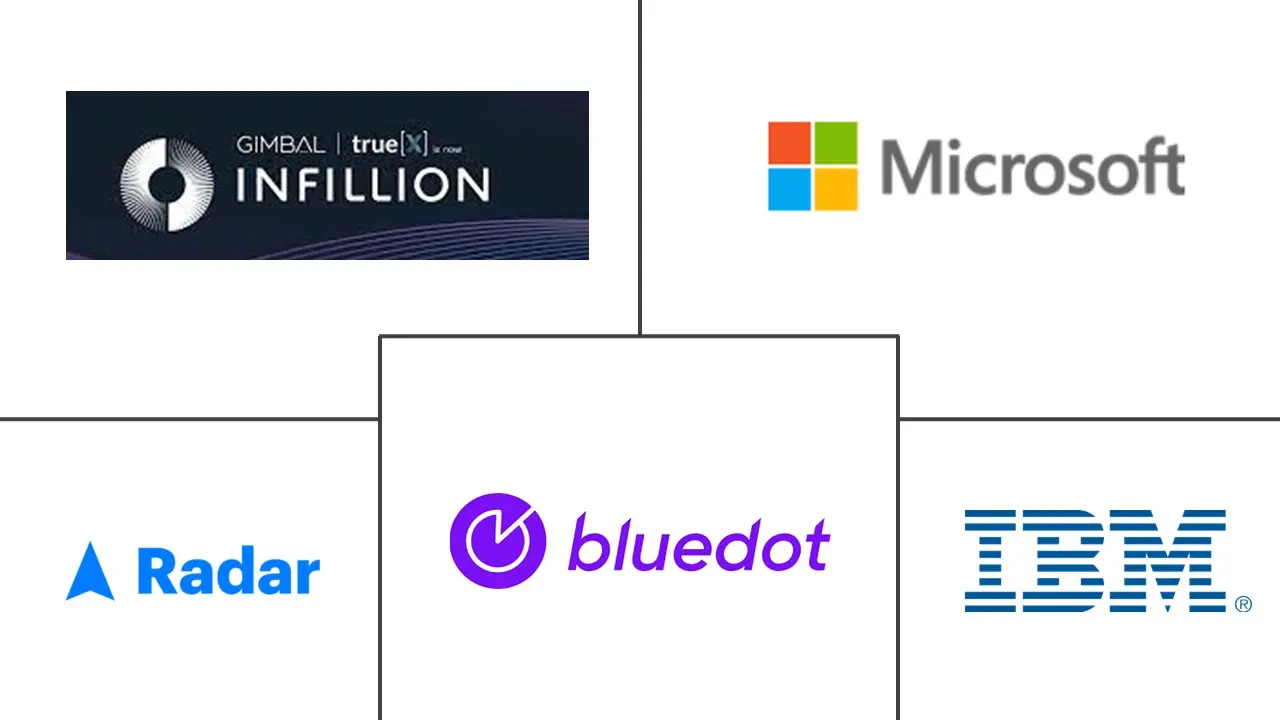Market Size of Active Geofencing Industry

| Study Period | 2019 - 2029 |
| Market Size (2024) | USD 1.81 Billion |
| Market Size (2029) | USD 5.16 Billion |
| CAGR (2024 - 2029) | 23.23 % |
| Fastest Growing Market | Asia Pacific |
| Largest Market | North America |
Major Players
*Disclaimer: Major Players sorted in no particular order |
Active Geofencing Market Analysis
The Active Geofencing Market size is estimated at USD 1.81 billion in 2024, and is expected to reach USD 5.16 billion by 2029, growing at a CAGR of 23.23% during the forecast period (2024-2029).
Active geofencing is growing due to more effective use of Spatial Data, improving Real Time Location Technologies, and increased adoption worldwide for location-bassed applications by consumers.
- Geofencing is a location-based service used by each end user, for which an application or software uses technologies such as GPS, PFID, WiFI, and mobile data to enable them to trigger preprogrammed actions when the device leaves virtual boundaries of geographical zones known as geofences.
- How people and businesses interact with the world and make huge savings has changed due to the increased use of spatial data and real-time location technologies. All kinds of devices and systems are connected to the Internet, such as phones, Smart buildings, car navigation systems, industries, or fleets of autonomous vehicles. Technology that provides real-time location data is required to maintain the system's proper functioning on a daily basis.
- With technological flexibility and capabilities, advancement in Active Geofencing is increasing. The market's growth is driven by trends such as digital marketing and clustering, autonomous cars, increased adoption of Bring Your Own Device, etc. The market studied, therefore, is expected to remain robust and will have a significant growth contribution from players in the market.
- Increasing concerns and regulations regarding location tracking can threaten active geofencing technologies. Moreover, active geofencing solutions are being held back due to the lack of regulatory bodies dealing with privacy and data collection in various regions.
- The COVID-19 virus increased the use of Active Geofences in several sectors, such as healthcare, industry, and many others. For example, an application had to be submitted by individual companies to identify staff at their premises and communicate with them directly and immediately. Active geofencing has facilitated secure, timely communication during an emergency.
Active Geofencing Industry Segmentation
Geofencing uses GPS, cellular technologies, or Wi-Fi to track the devices required to be monitored against defined geofences. Geofence is the virtual perimeter surrounding the physical location configured using maps. Active geofences need users to opt-in for location services through GPS or radio frequency identification (RFID).
The active geofencing market is segmented by organization size (small and medium-scale businesses and large-scale businesses), end-user industry (BFSI, defense, government and military, healthcare, industrial manufacturing, retail, and transportation and logistics), and geography (North America, Europe, Asia-Pacific, Latin America, and Middle-East and Africa).
The market sizes and forecasts are provided in terms of value (in USD) for all the above segments.
| By Organization Size | |
| Small-Scale and Medium-Scale Businesses | |
| Large-Scale Businesses |
| By End-user Industry | |
| Banking, Financial Services, and Insurance | |
| Retail | |
| Defense, Government, and Military | |
| Healthcare | |
| Industrial Manufacturing | |
| Transportation and Logistics | |
| Other End-user Industries |
| By Geography | |
| North America | |
| Europe | |
| Asia Pacific | |
| Latin America | |
| Middle East and Africa |
Active Geofencing Market Size Summary
The active geofencing market is experiencing significant growth, driven by advancements in spatial data utilization and real-time location technologies. This market is characterized by the use of location-based services that leverage technologies such as GPS, RFID, WiFi, and mobile data to create virtual boundaries, or geofences, that trigger preprogrammed actions when crossed. The increasing integration of these technologies across various sectors, including retail, healthcare, and transportation, is reshaping how businesses interact with consumers and manage operations. The retail sector, in particular, is witnessing a surge in demand for active geofencing as it allows for targeted advertising and personalized customer engagement, leading to higher returns on investment. The market's expansion is further supported by trends such as digital marketing, autonomous vehicles, and the adoption of Bring Your Own Device policies, which are enhancing the capabilities and flexibility of geofencing solutions.
North America is a leading region in the active geofencing market, bolstered by its advanced communication and internet infrastructure and a strong presence of companies in the BFSI, retail, and logistics sectors. The region's market is semi-consolidated, with key players like Bluedot Innovation Pty Ltd, IBM Corporation, and Microsoft Corporation actively engaging in strategic partnerships and acquisitions to enhance their market share. Despite the promising growth, the market faces challenges from regulatory concerns regarding location tracking and data privacy. However, the COVID-19 pandemic has accelerated the adoption of active geofencing in various industries, highlighting its importance in facilitating secure and timely communication. As the market continues to evolve, the integration of geofencing with augmented reality and other advanced technologies is expected to further drive its adoption, particularly in the retail sector, where personalized and digital-first shopping experiences are becoming increasingly prevalent.
Active Geofencing Market Size - Table of Contents
-
1. MARKET INSIGHTS
-
1.1 Market Overview
-
1.2 Industry Attractiveness - Porter's Five Forces Analysis
-
1.2.1 Bargaining Power of Suppliers
-
1.2.2 Bargaining Power of Buyers
-
1.2.3 Threat Of New Entrants
-
1.2.4 Threat of Substitute Products
-
1.2.5 Intensity of Competitive Rivalry
-
-
1.3 Industry Value Chain Analysis
-
1.4 Impact of COVID-19 on the Market
-
-
2. MARKET SEGMENTATION
-
2.1 By Organization Size
-
2.1.1 Small-Scale and Medium-Scale Businesses
-
2.1.2 Large-Scale Businesses
-
-
2.2 By End-user Industry
-
2.2.1 Banking, Financial Services, and Insurance
-
2.2.2 Retail
-
2.2.3 Defense, Government, and Military
-
2.2.4 Healthcare
-
2.2.5 Industrial Manufacturing
-
2.2.6 Transportation and Logistics
-
2.2.7 Other End-user Industries
-
-
2.3 By Geography
-
2.3.1 North America
-
2.3.2 Europe
-
2.3.3 Asia Pacific
-
2.3.4 Latin America
-
2.3.5 Middle East and Africa
-
-
Active Geofencing Market Size FAQs
How big is the Active Geofencing Market?
The Active Geofencing Market size is expected to reach USD 1.81 billion in 2024 and grow at a CAGR of 23.23% to reach USD 5.16 billion by 2029.
What is the current Active Geofencing Market size?
In 2024, the Active Geofencing Market size is expected to reach USD 1.81 billion.

